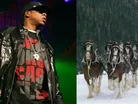Budweiser Hires Jay-Z to Wage War Against Craft Beer

Budweiser has an image problem: craft beer is what Generation X and Millennial consumers are interested in right now, and Budweiser is essentially the polar opposite of a craft brewery. What’s a macrobrewery to do? The answer may be to take a hard look at the way you’re marketing your brand and make some updates to appeal to the younger demographic it needs to beat the craft beer tidal wave and survive. In the case of Budweiser, it also involves hiring Jay-Z and putting the brand’s famous Clydesdale horses out to pasture.
The problems that Budweiser faces with the rise of craft beer’s popularity are not exaggerated. As Fortune reports, spin-offs and loss of appeal have been conspiring to degrade the value of the Budweiser brand among younger consumers for a quarter of a century now:
So on one side, craft breweries are growing with no sign of stopping; on the other, malt beverages like Bud Light’s own Lime-a-Rita are chipping away at another piece of valuable market share. While Budweiser parent company AB InBev may be working hard to enter the craft brewing market through savvy acquisitions, that does little to help its premium domestic brands and still leaves Budweiser itself responsible for building up its own presence within its sector.
The brand has been putting a lot of thought into how to appeal to younger consumers in the 20-something age range. According to date from the National Beer Wholesalers Association, this demographic represents “the largest number of new drinkers since the Baby Boom.” It’s a generation that is increasingly interested in brands that can offer engagement and an experience beyond the product itself, so this holiday season Budweiser is experimenting with that idea and delving heavily into experience-based marketing:
Beyond evoking the emotions that come with experiences, Budweiser is also planning to get into offering the younger beer-drinking demographic actual real life experiences as well—that’s where the partnership with Jay-Z comes in, in the form of a music festival:
Of course, sometimes you have to let go of something old in order to make room for something new. For Budweiser, that means letting go of its traditional Clydesdales that have been (up ‘til now) faithfully trotted out during the holiday season every year since 1987. The Clydesdales will be stabled this year with this new marketing strategy taking its place.
Is it the right move? That’s still up for debate—younger consumers do still love cute animal commercials, after all. Budweiser may have to try out a few new marketing moves before something sticks and catches consumer interest in a major way. Worst case scenario, the brand may have to wait it out in a smaller capacity until it becomes kitschy in the vein of Pabst Blue Ribbon. But it’s clear at this point that the tried-and-true path it’s on right now isn’t working. For the Budweiser brand to stay afloat, it’s going to have to set a new course.
[SOURCE: Wall Street Journal via Fortune]
Featured Articles
Fresh investment supports TRACT in enhancing tools for sustainability in the food and agricultural sectors, aligning with EU regulations
The devastating floods in Spain have shaken up the global citrus supply, heightening challenges in the fruit juice drinks market
McDonald's has spent 40 years supporting students with scholarships & plans to continue, despite Robert F. Kennedy Jr.’s plan to Make America Healthy Again

